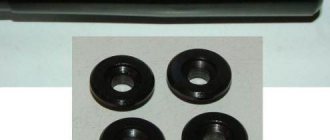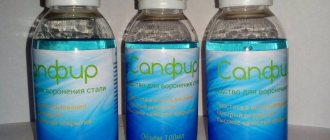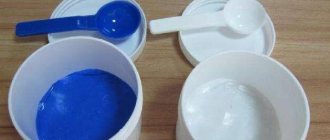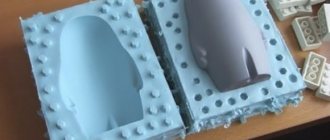- November 23, 2018
- Weapons and ammunition
- Natali Michaelis
“How to blue the barrels of a hunting rifle at home?” – one of the most frequently asked questions on thematic forums. As a rule, novice hunters who have just begun to comprehend the beauty of this fishery are interested in this. From a technologist's point of view, steel bluing is a complex process of applying a very thin coating to metal using various chemical reactions. You will find information on how to do this at home in our article.
Significance of the procedure
Most gun lovers are interested in this issue when they want to decorate the barrel of a gun more beautifully. However, this process has at least two more advantages: coating the metal with a thin film gives the barrel different shades, which increases its camouflage (especially in the sun), and the weapon will also be less susceptible to corrosion in the future. For a true hunter, both of these factors should be truly important. Therefore, it is worth approaching the bluing of hunting rifle barrels at home with great responsibility.
How to clean rifled weapons?
People on forums often ask questions about how to clean weapons and why it is needed. If you properly lubricate rifled guns, pistols and carbines with gun oil after each shooting, they will serve you for a long time without complaints.
Beginning athletes are often interested in how to clean rifled weapons. In order to prevent breakdowns, delays and metal corrosion, a number of rules should be followed:
- The rifled barrel must be cleaned in a certain sequence: first get rid of carbon deposits and harmful deposits in the breech, and then begin processing the opposite side. That is, cleaning should be done in the same direction in which the bullet flew during shooting.
- Using the same principle, it is necessary to guide the cleaning rod with a clean rag wrapped around it. It is also allowed to clean the bores with a cleaning rod equipped with a brush.
- Moving the cleaning rod in the opposite direction is highly undesirable, since in this case scratches may form on the metal part of the weapon.
- After each procedure, the brush must be cleaned of carbon deposits and metal parts that have settled on it.
- A brush for cleaning weapons must be purchased with stiff bristles, since soft hairs very quickly become clogged with deposits as a result of the combustion of gunpowder. And it is extremely difficult to get rid of them.
- Rifled weapons must be cleaned immediately after shooting. Failure to do so will inevitably lead to unsuitability of the product.
- It is necessary to clean the barrels and components of a rifle with rifling even when it is not used for its intended purpose. As a rule, it is enough to carry out this process once every few days. Even if the weapon is in the closet, it needs to be lubricated and cleaned periodically.
- If the weapon was fired, it is advisable to immediately begin the procedure in question. After two days it is recommended to repeat it. Only after this the rifled weapon is ready for long-term storage. Do not forget that even with long-term storage, shotguns and pistols must be subjected to a cleaning procedure.
- The most vulnerable elements in a weapon are the muzzle and the bullet exit of the barrel. They need to be especially carefully cleaned and generously lubricated with gun oil.
- It is highly undesirable to use compounds and lubricants that are not intended for cleaning weapons. You should also not apply homemade alkaline compounds to metal. If you neglect this recommendation, you can ruin your expensive firearm.
- After thoroughly cleaning the barrel, all metal components and mechanisms must be lubricated with special oil, which is designed to protect against corrosion.
Features of the technology
You can often hear people say that bluing a gun can only be done in a factory setting; however, this statement is only half true. Yes, steel undergoes higher quality chemical treatment during the industrial process. This is explained by the high content of iron oxide in the substances used at the plant.
At home, achieving high-quality blackening of metal can be very difficult. According to some experts, oxidation of steel can only occur at the factory, however, this is not the only way in which a barrel can be blued. Most "home" technologies are divided into three main groups according to the fundamental principles that are necessary to carry out the process.
It is customary to highlight:
- oxidizing agent treatment;
- hot bluing of steel;
- cold blued steel.
Each of these processes has both its pros and cons. Features of the technology, as well as the step-by-step implementation of each process will be described in the following sections. However, first you need to familiarize yourself with the safety regulations, compliance with which is mandatory.
Popular bluing methods
The most common methods of bluing at home are:
- alkaline;
- thermal;
- acidic.
The alkaline method is well suited for self-use at home. It will require
- water;
- precision scales;
- sodium nitrate and hydroxide.
For the coating to become durable, the process must last at least an hour and a half.
Alkaline
The technology for bluing steel using the alkaline method at home is divided into the following operations
- Degrease the surface with a solvent or special degreaser.
- Pour 100 g of water into a stainless steel container with a capacity of at least a liter.
- Add 120 g of caustic soda and 30 g of sodium nitrate, stir thoroughly until completely dissolved.
- Heat the solution to 130-145 °C.
- Place the product in the dish, avoiding touching the walls.
- After 20 minutes, after the part has turned black, rinse it in distilled water.
- After drying, generously lubricate the product with machine oil and wipe thoroughly.
Steel bluing with alkali
Careful adherence to proportions and parameters will allow you to obtain a smooth and abrasion-resistant coating that does not require polishing.
Acid
This method involves the use of acidic solutions.
Before starting processing, you should carefully remove all rust from the surface of the object. To do this, use ordinary sandpaper, and in hard-to-reach places and with severe rust, use a grinder or a screwdriver with a wire brush.
Means for degreasing steel before processing
Next, chemical cleaning is carried out. It is used for
- sodium triphosphate;
- ethanol mixed with kerosene;
- or pure kerosene.
The product is placed in a container with the solution so that it completely covers it and kept for at least a quarter of an hour. After cleaning, the product is washed with plenty of water and dried.
The composition for acid bluing consists of:
- water: 1 l;
- tannic acid: 2g;
- tartaric acid: 2g.
After thorough mixing and complete dissolution, the composition is heated to 150 ° C and the workpiece is completely immersed in it. Leave for 15 minutes, then rinse with running water and briefly dip in boiling water for complete and high-quality rinsing.
Components of the solution for bluing
The last stage of the process is soaking in machine oil for an hour. After drying, the product is ready for use.
Thermal
Thermal bluing is the oldest and simplest method for home use. The whole process boils down to heating the steel in the open air. It lasts until the upper layers of steel react with oxygen in the air and result in an oxide film. The more a part is heated, the darker it becomes.
Thermal bluing
It should be remembered that heat treatment also changes the physical properties of the steel of the entire product.
Preparatory procedures
Whatever method you choose for bluing a gun barrel, you must perform a number of preparatory procedures in a certain sequence, which will be described below.
- We carefully clean the surface of the barrel on which the steel will be blued using a cleaning rod.
- We polish the surface to perfect condition.
- We disinfect the surface (after this, all work is done exclusively with rubber gloves).
- We use special substances for bluing metal.
- We re-process the surface with a grinder.
After this, you can start bluing the metal, observing safety regulations.
What methods are available to perform at home?
Complex technological operations are not possible at home, but simpler procedures are quite possible. There are several basic bluing methods:
- cold;
- hot;
- oxidation.
All three methods can be done at home, for which you need to acquire all the necessary materials and equipment, as well as study and understand in detail the physical and chemical essence of the processes. It is not recommended to get down to business without understanding the meaning of the operations being performed. Any method consists of the same steps:
- Cleaning, removal of old coating and rust.
- Grinding, removal of cavities, small scratches, dents.
- Degreasing. The surface layer of fat is removed, for which various chemical reagents are used. After completing this stage, work with metal only with rubber gloves.
- Actually bluing.
- Finishing the metal surface.
The most important point (apart from the coating itself) is degreasing. After this you can start bluing. Let's consider the possible options.
Cold bluing
The principle of cold bluing is simple - a special liquid is applied to a previously prepared surface. There are ready-made formulations:
- raven 3;
- Parisian oxide;
- rusty varnish.
The first two products are sold in stores. With the third, the matter is more complicated - in its finished form it is stored for a long time, but it is practically never on sale, there are only advertisements for the sale of old stocks. Making rusty varnish is a complex and dangerous procedure, since you have to mix 50 ml of hydrochloric and 54 ml of nitric acids, 30 g of steel or cast iron filings, and 20-30 g of scale.
All this is dissolved in 1 liter of distilled water, not immediately, but gradually:
- A third of nitric acid and a third of chips with scale are carefully poured into hydrochloric acid. The reaction will begin, you must wait for it to subside.
- Repeat the procedure and wait for the end of the reaction again.
- Pour out the remaining chips and scale, pour out the last third of the nitric acid. Seal and leave for a day. Then add a liter of distilled water to the resulting brown solution, after which the rusty varnish is ready. You can use it for a long time, it becomes harmless and does not require special precautions.
The composition is applied with a regular brush . It is necessary to ensure the uniformity and penetration of liquids into all corners and crevices of the parts. After finishing the work, the part is washed and polished.
Hot bluing
This method is the easiest. First, the part is heated, after which it is immersed in oil (as an option, the surface is smeared with a swab dipped in oil). The best option (as it is believed) is linseed or hemp oil, somewhat worse - drying oil. Mineral (machine) oil can also be used, but after it the results are considered the worst. Some masters advise waiting a while after applying the oil, then removing the excess. Others recommend baking the butter with a blow torch, which creates a thick black coating.
There is definitely no best recipe, since everyone has their own conditions for heating and applying oil, different temperatures and other nuances that affect the result. Everyone agrees on one thing: after the first application of oil and a short exposure, it should be thoroughly wiped off. This allows you to remove residual fats, which in any case cannot be dissolved during degreasing. The procedure of heating and applying oil is then repeated several times until the best result is achieved. In this case, you must act carefully, since the properties of the metal change when heated, and you can loosen the barrels too much.
Oxidation
Various types of nitrates or nitrites are used for oxidation. The procedure consists of immersing the prepared part in the molten mixture. The temperature is quite high, which is a serious limiting factor for use, since strong heating is contraindicated for critical parts, and gun barrels are such. There are many recipes for oxidizing agents designed for different temperatures, but to obtain the maximum effect, you must have strictly dosed heating that promotes an optimal reaction regime. It is difficult to organize this at home, so self-blueing by oxidation in artisanal conditions is rarely used.
Safety precautions
It is not difficult to guess that bluing the barrels of a hunting rifle at home is a rather dangerous procedure, so compliance with safety measures must be unconditional. To begin with, it is worth noting that chemical solutions contain a large number of active substances, which must be stored in a place inaccessible to unauthorized people. Also, do not forget that the entire process must be carried out in special containers.
Blueing of hunting rifle barrels at home should be carried out in a well-ventilated room, since breathing chemicals and dust is quite harmful to the human body. To sand the surface, it is best to use fine-grained sand, sandpaper or pumice.
Safety regulations
Carrying out the bluing procedure at home creates a certain danger both for the master himself and for others. It is necessary to understand that the term “home conditions” itself is quite vague and can be interpreted within wide limits. Any coating method requires heating or the use of aggressive or active chemical compounds. Therefore, it is unlikely that it will be possible to carry out work in an apartment, and, at a minimum, it is not recommended. In addition, it is necessary to protect yourself, your loved ones, and property from possible troubles to the maximum extent possible. At any moment something can go wrong, and you need to be prepared for it.
The use of chemical reagents requires high-quality ventilation and the use of personal protective equipment - goggles, rubber gloves and apron, respirator. All manipulations with acids are best done outdoors, on the windward side. It is also necessary to monitor the direction of the wind so that chemical vapors do not blow into the house.
If heating is required, proper fire safety precautions must be taken. Burnishing using oil must be done with a high-quality hood or in the open air. The smoke produced by burning oil is harmful to health and can cause poisoning.
Self-blueing is sometimes the only available method for refinishing the barrel coating. Therefore, when deciding to perform a procedure, it is necessary to study the technology, obtain as much information about it as possible and carefully consider the procedure. Only after this can you begin preparing materials and tools and choosing a workplace. The result depends on the accuracy and preparedness of the master, the thoroughness of all stages of work.
Solution and brush
In specialized stores you can purchase various types of chemical mixtures that are used to blue gun barrels. As a rule, most of them are applied with a regular brush to the metal surface. Among such products, the most popular are “Voron-3” (domestic version) and “Parisian oxide” (imported mixture).
The advantages of this method can be seen with the naked eye. The process is quite simple, and you don’t have to make the bluing liquid yourself. Security requirements are also minimal.
However, this method also has certain disadvantages. Firstly, using a brush it will be quite difficult to penetrate into all the “cracks” of the weapon, due to the complexity of its configuration. Also, to make the product smooth, you will have to resort to additional polishing. Well, the most unpleasant thing is that when barrels are blued using a cold method, even slight chemical damage will leave a strong mark, after which the treatment will have to be repeated.
What is it used for?
Initially, the procedure was carried out solely for the purpose of protection against rust, since there were no other types of coating, and the operating conditions of the weapon greatly contributed to the development of corrosion processes. Currently, in addition to its protective functions, bluing is considered as a decorative coating that gives weapons a traditional look. It is noteworthy that the appearance of a weapon is considered by a large number of owners to be one of the most important components of its performance, while protection against corrosion is not considered a problem at all. However, all currently used types and methods of bluing provide a sufficient degree of protection of the metal surface from moisture. It is also necessary to understand that any bluing agent does not create a coating layer, but only promotes the formation of a reaction as a result of which this layer appears on the surface of the metal.
Immersion method
This method involves immersing metal parts of the weapon in a solution. The main advantage of this method of bluing a gun barrel at home is that the liquid will penetrate even the most inaccessible parts of the parts, which is why the coating layer becomes more uniform. Also, the liquid does not splash, unlike the first case, when it is applied with a brush.
You can prepare such a solution yourself or purchase it ready-made in a specialized store. For the first case, you will need to mix the following ingredients:
- FeCl3 (iron chloride) – 75 grams.
- HNO3 (nitric acid) – 20 grams.
- CuSO4 (copper sulfate) – 20 grams.
- C2H5OH (ethyl alcohol) – 30 grams.
After preparing all the reagents, you must mix them one by one in a glass container, waiting for the reaction to take place. When immersing a metal part, you must wear special protective gloves, otherwise you risk getting skin burns from nitric acid. The metal should be kept in the solution for about 30 minutes (depending on the quality of the steel), after which it should be thoroughly washed under running water using any detergent.
How to get a faded color?
We fill a metal box to the size of the part with small birch charcoal and place it in a well-heated forge or in a barrel with burning wood chips. When the coal heats up and begins to smolder, we place a vinegar-wiped and dried steel part into it, and then monitor the stages of its heating. At the very beginning of the appearance of blue, take out the workpiece and cool slightly in air, while cleaning it with soft charcoal.
Another method is using a special solution and without heat treatment. For it you need to get only 2 reagents: 2.5 grams of potassium hexacyanoferrate, popularly called red blood salt and which is a powerful oxidizing agent, as well as iron sesquichloride. Both ingredients dissolve perfectly, so feel free to pour 0.5 liters of water into each in a separate container, then combine the resulting liquids into a single mixture.
There are more complex methods of blueing, but we will turn to those that are simpler. Oxidation can be carried out not only with solutions, but also with melts of various substances. In particular, a dark blue color can be given to a steel product by immersing it in molten sulfur, into which a small amount of soot is first mixed after turning into a liquid state.
Steel, which acquires various shades of gray as a result of bluing, looks beautiful, and a fairly strong film of oxidized metal is obtained that protects against rust. You can obtain a color in this spectrum in a simple way, which, however, is only available for small products. You will need 70 grams of copper nitrate and 30 grams of denatured alcohol, the first reagent is a salt, the second is an alcohol.
The following components are needed: 24 percent hydrochloric acid - 120 grams, 90 percent alcohol and water - 100 grams each, sublimate - 40 grams and 2 times less bismuth chloride with copper chloride. Mix acid and water, add alcohol and divide the resulting liquid into 3 equal parts. Pour the last 3 components related to salts separately into each part of the solution and then mix everything in one container. The steel product is immersed in the resulting bath for half an hour, after which it is removed and boiled in clean water. If necessary, repeat the process.
To achieve a faded color on the surface of your product, you need to know very well at what temperature it appears and what duration of heating is necessary to fix it on the metal. The main condition: firing with a flame must take place for a strictly defined time. Therefore, if you want to enhance your product with a tan color, choose a small item, because it will be almost impossible to heat a large area of metal evenly on a gas stove or blowtorch.
Once you have achieved the desired color, immediately remove the product from the heat and let it cool. Then rub it with oil to set the color.
Burnishing with rusty varnish
Such a knife is not suitable for bluing edged weapons, since the steel on most knives is poorly resistant to mechanical stress and wears out quickly. However, if you still want to bury your hunting dagger, then it is best to use rusty varnish - one of the most effective and low-cost methods. The essence of the method is to treat the surface with a corrosive medium - rusty varnish. By the way, this method is also suitable for bluing barrels.
The preparation of rusty varnish must be carried out outdoors or in a well-ventilated area. To avoid inhaling harmful gases during the process, use a special protective respirator. First, you need to place 12 grams of hydrochloric acid in a glass container, then add 20 grams of nitric acid. It is worth paying special attention to the fact that reagents should be measured by weight and not by volume, since they have different densities. Even one extra gram can lead to impaired reactions. Then 30 grams of rust (iron scale) and 5 grams of iron filings are added to the dishes.
After this, you need to wait some time for the reaction to pass. As soon as the process occurs, you need to add 50 grams of medical alcohol (ethyl alcohol C2H5OH) and 50 grams of distilled water to the solution.
The trunks are immersed in the solution for 12 hours, after which they must be treated to remove salts and scale that have precipitated. After this, the parts are re-immersed in the solution and kept in it until the metal turns black. After this, the metal is washed with cold water, and the red marks left by the solution are brushed off. As a result of such procedures, you can get a fairly good result of barrel bluing at home.
As in the case of using a brush, after the procedure the part is washed well under cold water using detergents. If you decide to bury a knife in this way, then the time the blade is kept in the solution should be controlled by you personally, since the steel on knives is different from gun steel. Prolonged exposure to rusty varnish can negatively affect the quality of bladed weapons.
Bluening process
During the bluing process, a film of iron oxide forms on the part. Its thickness depends on the technology used and can range from 1 to 10 micrometers.
There are several ways to process metal:
- Alkaline.
- Acid.
- Thermal.
Next we will look at each of them.
Alkaline method
In alkaline solutions, bluing is performed with oxidizing agents at a temperature of 130 – 150°C. The basis of alkaline oxidation is the process of iron oxidation.
- It is best to use a stainless steel container to prepare the solution.
- Pour 100 ml into this container. water and dissolve 120 g in it. caustic soda and 30 gr. sodium nitrate. Stirring is carried out until the solid sediment disappears.
- The resulting mixture must be heated to 130‒150°C.
- The part is immersed in a boiling solution, but it should not touch the walls of the container.
- After 20 minutes the metal will turn black, after which our part must be removed and washed with distilled water.
- After the part has dried, it must be lubricated with machine oil and then wiped dry.
- The surface is smooth, wear-resistant and does not require additional polishing.
Acid method
Acid bluing is performed in acidic solutions using chemical or electrochemical methods.
- If the part is rusty, then you need to clean it with sandpaper. You can speed up the cleaning process by using an angle grinder with a wire brush.
- Now you need a cleaning solution. This can be ethyl alcohol with kerosene or kerosene. You can also use sodium triphosphate.
- The part is immersed in the solution for 15 minutes, after which it is washed with running water and dried (or wiped).
While the part is drying, prepare a solution for acid bluing. The following components will be required:
- water – 1 l.
- tannic acid – 2 gr.
- tartaric acid – 2 gr.
Now let's start bluing the metal part.
- The components are mixed and heated to 150°C.
- The part is lowered into the container and left for 15 minutes, after which it must be rinsed with running water.
- You can finally get rid of the solution on the part by dipping it in boiling water.
- The final stage of bluing will be immersing the part in machine oil for 1 hour, after which it must be wiped and can be used for its intended purpose.
Thermal method
Thermal bluing technology is the oldest, and probably the simplest. The essence of the method is to heat a metal product in the open air until the oxygen contained in the air enters into a chemical reaction with the top layer of the part. The stronger the heating, the darker the part becomes, because the oxidation process takes place at a greater depth.
Using oil
The method in question is simple to use at home. We will need the following ingredients:
- Machine oil – 500 ml.
- Metal container for oil.
- Tool for holding the part (pliers, pliers, pliers, etc.).
- Gas-burner. If it is not there, then you can use a gas stove or a hair dryer.
- Paper napkins or rags.
Next, we will consider the procedure for using a hair dryer.
- The parts must be laid on a non-flammable surface (brick, for example).
- The hairdryer should be set to high heat.
- The part needs to be heated as much as possible.
- The heated metal, held with pliers, must be lowered into the bath so that it is completely immersed in the oil.
- After removing the part from the oil, place it on a paper towel to absorb the oil.
- The part needs to be heated again and lowered into the oil - the process is repeated 3-4 times.
Each bluing cycle makes the part darker.
Hot bluing
Are you interested in how to bury a gun at home? Many craftsmen prefer to use the hot method, considering it the only correct one. The arguments are quite simple. For a product that has been blued using a hot method, the protective coating lasts much longer, and the absence of harmful fumes during the procedure is an additional advantage.
This method is also commonly called oil bluing, since the technology involves the use of this substance. This method is quite simple. First, the part is heated to a high temperature, after which it is immersed in oil. Gun oil, olive linseed oil, or even machine oil can serve as a quenching liquid - this is not so important. The part is kept in the container for about 10 seconds, after which it must be removed, otherwise the metal will become covered with various stains.
The next step is to “boil” the oil on the surface. For this purpose, you can use a blowtorch or a stationary gas stove. An important point in blueing steel is determining the moment the part is “ready”. Experienced gunsmiths say that you need to stop heating the liquid the moment the gun barrel turns black. Oil is one of the oldest and most effective means for bluing the barrels of hunting weapons. Reviews about this method on thematic forums indicate its effectiveness.
What is bluing?
Burnishing is the application of a thin film of oxides to the previously prepared surface of steel or cast iron parts, protecting against corrosion and giving the metal a bluish-black color. The thickness of the film ranges from 1 to 10 microns; the thicker it is, the deeper and darker the color of the coating. The classic method of bluing, used for several hundred years, is to apply drying oil or linseed oil to the surface of heated metal. The result is a fine-crystalline coating that has protective anti-corrosion properties and a pleasant blue-black color. It is customary to judge the heating temperature by color, although this method is not very accurate. The blue color, most suitable for bluing, appears when steel is heated to 300-320°.
The coating obtained in the traditional way was not distinguished by proper strength, durability, and did not provide complete protection against rust. Over time, other, more effective methods of bluing metal were developed. Most of them were created specifically for weapons, since the specific service of weapon metal did not allow other finishing methods. One of the reasons for the need to use other coating methods was the task of abandoning the heating of weapon barrels, which had a negative impact on the condition of the metal, its physical and chemical properties.
Oxidizing agent treatment
For a person who understands chemical processes, the question of bluing barrels should disappear by itself. The first thing that should come to mind is the need to treat the trunks with a special oxidizer. The only disadvantage of this method is that the mixture must be heated to the melting point, however, it is not always possible to do this at home. Most often, the processing is carried out using various nitrates, which is why the second name of the process came from - bluing of trunks in saltpeter. Although the choice of oxidizing agents is not limited to it, saltpeter is most often used at home - safely and effectively.
Methodology
Immersion time in the chemical composition does not exceed 30 minutes. During this half hour, you must carefully monitor the immersed parts and remove them as soon as they are completely blackened. This technique allows you to blue barrels at home, obtaining a hard metal coating that will not violate its integrity.
The metal oxidation method is considered quite effective, but very expensive and difficult for beginners. The process will require a certain skill and good knowledge of chemistry from the gunsmith. It should also be noted that bluing of stainless steel must be carried out with other reagents.
Where are specialists trained?
Many men are wondering where they can get training to become a gunsmith. According to reviews, the most famous institute where new personnel are trained for the defense industry is the Bauman Moscow State Technical University. It is within the walls of this university that students are taught almost all existing weapons specialties. The following directions are open to future gunsmiths at the university:
- Faculty of Special Mechanical Engineering.
- "Shooting and cannon business."
- Artillery and missile direction.
- Faculty for the study of weapons and various ammunition used in modern warfare.
The duration of training lasts from 5 to 5.5 years, depending on the chosen specialty.
In Izhevsk there is a school of “Weapons Mastery”, which operates on the basis of the Izhmash enterprise. There they train to become a mechanic, specializing in repairing various types of weapons.
In the hero city of Tula there is an educational school where they teach such working professions as:
- Locksmith.
- Milling operator.
- Turner.
- CNC machine operator.
- Machine operator.
After completing their studies, students are gladly hired to work at defense enterprises in our country.
Video
If you are interested in the process of “home” barrel bluing, we recommend that you familiarize yourself with the following video. It will help you more clearly understand all the stages of cold bluing.
In conclusion, it is worth noting once again that bluing barrels at home is a rather hazardous process for health, so it must be carried out only with unconditional adherence to safety precautions. When using various reagents, be sure to use protective gloves, and carry out all work in a well-ventilated area.











